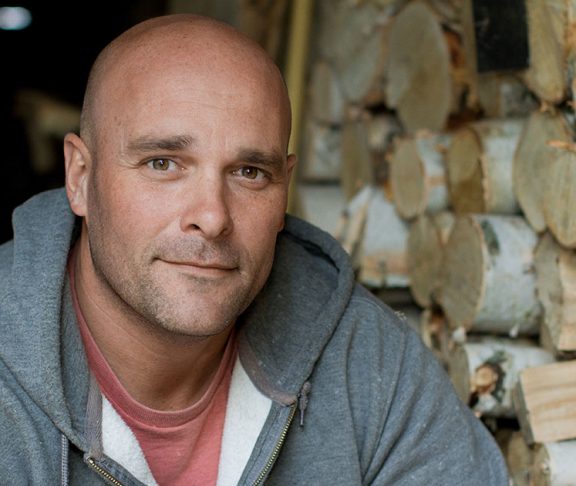Get valuable insight about starting and running your own construction company from HGTV’s Bryan Baeumler.
What motivated you to pursue a career in the construction industry?
Growing up my Dad was a blue-collar guy. He owned a sheet metal business at the airport in Toronto. Anything we did at home, we did ourselves as a family — so I was always surrounded by tools. It became a passion for me.
What was the hardest part about starting your own construction business? For others going through the same challenges, what advice would you provide?
The hardest part was just making the decision to do it. You have to be very self-motivated to get out of bed early every day and hit the pavement running before anyone else is on the track. When you’re self employed, nobody is going to call you into the office for a review to give you a confidence boost. You must be prepared to put in the hard work and time to make it a success — and pay your bills. When I first started out, I would drive three hours just to take a small job so I was at least working, honing my skills and learning every day. One of the hardest decisions I had to make was to say “No.” Choosing the right customer to work with, who has a budget that will allow you to do the job properly, means less work in the beginning but it gives you the opportunity to succeed and really show what you’re capable of in the long run. It’s less expensive to spend a few weeks without work than it is to get into the wrong job that’s set up for failure (and financial losses) from the beginning. The biggest piece of advice I can give to young tradespeople wanting to work for themselves is learn how to operate a business. I’ve met too many people that are highly skilled on the tools but can’t operate the business end of things and end up in financial trouble. If you learn how to operate a business properly, put in the hours, show up when you said you’d be there and do what you said you’d do, it’s hard to fail.
One of the biggest challenges our business faced was managing growth and placing the right people into key positions. As soon as you grow beyond owner/operator size, you are depending on other people to work hard and represent your name and brand. To be successful you must maintain constant communication with both your team and your customers and head off minor problems and miscommunications before they turn into big, expensive problems. I’ve learned some expensive lessons about people over the years. People will always be either the key to success or the cause of your failure in this business.
What is the main difference between working on a commercial project vs. residential?
Commercial jobs frequently come down to time and budget. The commercial customers, while invested in the project financially, aren’t usually as emotionally invested as someone who has their home ripped apart during a major renovation. In my experience most commercial jobs are also more utilitarian, whereas residential renovations usually have more opportunities for unique, fresh and interesting designs.
On your company’s website site, it says that regardless of size the planning process of any project will determine its success. What advice would you give to other contractors/construction professionals to ensure success during this initial phase of the project.
You can never plan enough and you can never communicate too much with homeowners/customers. Managing customer expectations and keeping them informed is the most important and challenging part of any renovation or build. My first question is always “What’s your budget?” From there, you can quickly assess whether their expectations are in line with the scope of work. And if they aren’t, you can have an open and honest discussions with them about what to expect right from day one. It’s always better to err on the side of longer schedules and bigger budgets right up front — it’s a much easier conversation to tell a customer you’re going to finish early and under budget than it is to have to constantly explain delays and budget increases. Spend as much time as you can (and use historical data from your own projects) coming up with a reasonable and achievable overall plan for the project.

What is the biggest impact that construction related technology has had on your business?
Technology is constantly changing in our business — and not always for the better. There are so many new products coming out to replace traditional methods and materials, and you really have to be careful to assess what makes sense for your skill set and where you want to focus. I’ve always been aware that there maybe 10 or 20 correct ways to complete a certain project, but there are always thousands of ways to do it incorrectly. In residential renovations, technology and science provides for a portion of the work to be completed, but at the end of the day it is the tradesperson (or artisan) that must place each piece correctly, with their own measured and experienced hands. While process related technology has its benefits and detriments, technological advanced in materials have certainly provided us with more sustainable, healthy and efficient products to build with. I always enjoy spending time at home and trade shows to see what’s new on the market and I attend as many information sessions as I can to learn new methods and materials that make sense to our business.
One of the technologies noted to have a big impact on construction in the coming year is 3D imaging laser scanning. Do you use this technology? And if so, how does 3D imaging laser scanning help your team to ensure the project is successful during the initial planning phases?
It’s an exciting technology — we haven’t used it yet. But, we’re looking into it and how to incorporate it into the design phase of our future projects.
How important is collaboration between all parties in the success of your business and the projects you work on? What steps have you taken to increase collaboration on projects?
Collaboration between all parties is a huge component when it comes to a successful project. Right from the initial consultation with a customer, the more trades and partners involved in the process that can be involved the better. Each individual has a different set of experiences and insight right from the design phase, so the earlier you can bring their ideas to the table the better prepared you’ll all be for the job ahead. Once initial budgets and designs have been established, we bring each trade into the process early to weigh in on the plan and give everyone an opportunity to bring ideas to the table — whether that’s new technology that will add value to the project, structural design ideas to streamline or simplify the construction process or rough in ideas that will provide for simpler upgrades in the future. Round table meetings with everyone involved right form the initial design phase are the key to a smooth and successful job.

